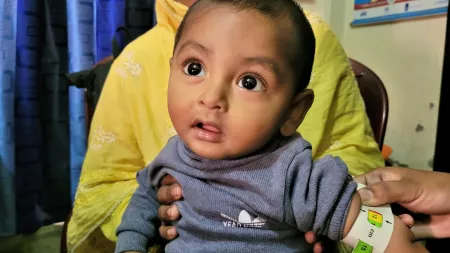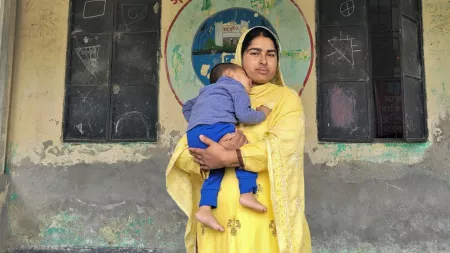When a baby is born in a rural village in Northern Bangladesh, the mother puts honey in its mouth, because then the baby will learn how to talk sweetly. “We had misbeliefs and didn’t know how important it is to breastfeed the newborn with colostrum within the first hour,” says Asma Akter, 30, mother of Araf, seven months. Colostrum or the first form of breastmilk is nutrient-dense and high in antibodies and antioxidants to build a newborn baby's immune system. It changes to breast milk within two to four days after the baby is born. Colostrum is thicker and more yellow than traditional breast milk.
There were many misbeliefs and the access to maternal healthcare information in the village was limited. “I didn’t know about health check-ups for pregnant women,” says Priyanka, 25, mother of Pollobi, 2. “Many women died during their pregnancy or while giving birth. This was normal and a risk we all took. The women gave birth at their homes, now most of us go to the community clinic.”
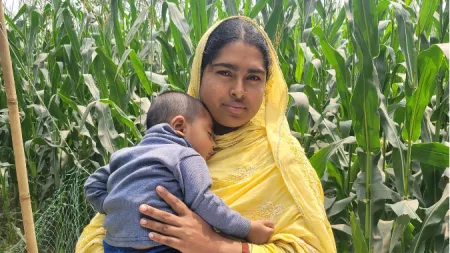
According to a study by the World Health Organization, Bangladesh has made progress in bringing down maternal mortality, from 441 death per 100,000 live births in 2000 to 123 deaths in 2020. A rate that is still very high. The UN Sustainable Development Goal Target 3.1 stipulates reducing the maternal mortality rate to less than 70 deaths per 100,000 live births by 2030.
Most of the complications from which women die are preventable. Access to maternal care and skilled birth attendants is believed to be of utmost importance in reducing maternal mortality. Almost half of all births in Bangladesh still take place at home without the help of skilled birth attendants. The WHO study shows that only 30 percent of mothers who have had no previous education in comparison to 63 percent of mothers with secondary education had access to a skilled birth attendant. Additionally, depending on how poor a woman is, the less likely she will have a skilled health professional at her side when she is giving birth. Only 32 percent of the poorest mothers in comparison to 86 percent of the richest have access to skilled delivery support.
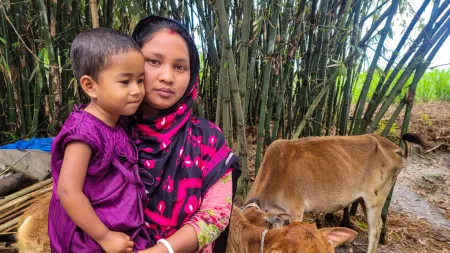
When Priyanka was 16, she was pregnant with her first child. When she was 9 months far along, Priyanka fell into the water pump hole next to her house. “After I fell, I kept silent. I didn’t know what to do. My belly turned hard. I was so frightened. In the end, my baby was dead,” she remembers with an absent gaze on her face. Since then, she has birthed two healthy children. “When my first baby died, I cried a lot and had a trauma. I am happier now with my healthy other children. Pollobi is in good health and gained good weight.”
Priyanka regularly visits the JANO sessions for mothers and pregnant women, where she is connected to other mothers and gains important knowledge on health, nutrition, and precautions she should take when pregnant. “After coming to the JANO sessions, I learned how important it is to take precautions. If my baby didn’t move, I immediately went to the doctor for a check-up,” Priyanka says. JANO (Joint Action for Nutrition Outcome) is a CARE project funded by the European Union and the Austrian Development Cooperation.
“I also learned a lot about what to eat during pregnancy. My husband is a day labourer, he works in other people’s fields. It is hard to support our livelihood. Without the community garden from JANO, we only ate rice and potatoes. Now we also eat vegetables and fruits daily,” says Priyanka. A balanced diet is essential to guarantee a newborn's healthy nutrition level. Close to one-third of children under five are affected by stunting in Bangladesh, which has implications for longer-term cognitive development and their future as adults. Poverty hinders access to the information and services necessary for early childhood development, and this is reflected in poor households’ higher rates of stunting, wasting, and mortality.
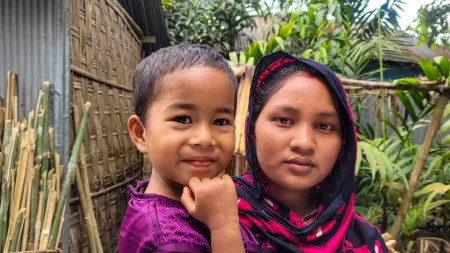
Asma’s son Araf is still slightly malnourished. His mother regularly goes to the community clinic for a health check-up. With JANO's support, she learnt that she has access to the clinic and how important monthly check-ups are. “I learnt a lot about nutrition. We now have access to nutrition service and I now know how to feed Araf correctly,” says Asma.
The JANO project has been working with participants to minimize the great challenges today in accessing nutritious food. Food prices are rising. Four years ago the price for 1 kilo of potatoes was 7-8 Takas, now it is more than 20 Takas. Additionally, most families didn’t know how to grow their own vegetables.
Now, the JANO community and household gardens provide nutritious vegetables and fruit. “We changed our way of cooking. Before we just cooked what we had without thinking about a balanced diet,” says Asma. When she birthed her first son, she had complications during the delivery. “I didn’t know what I know today. With Araf I didn’t have any complications. I am very happy that he is healthy and growing stronger every day,” concludes Asma.
